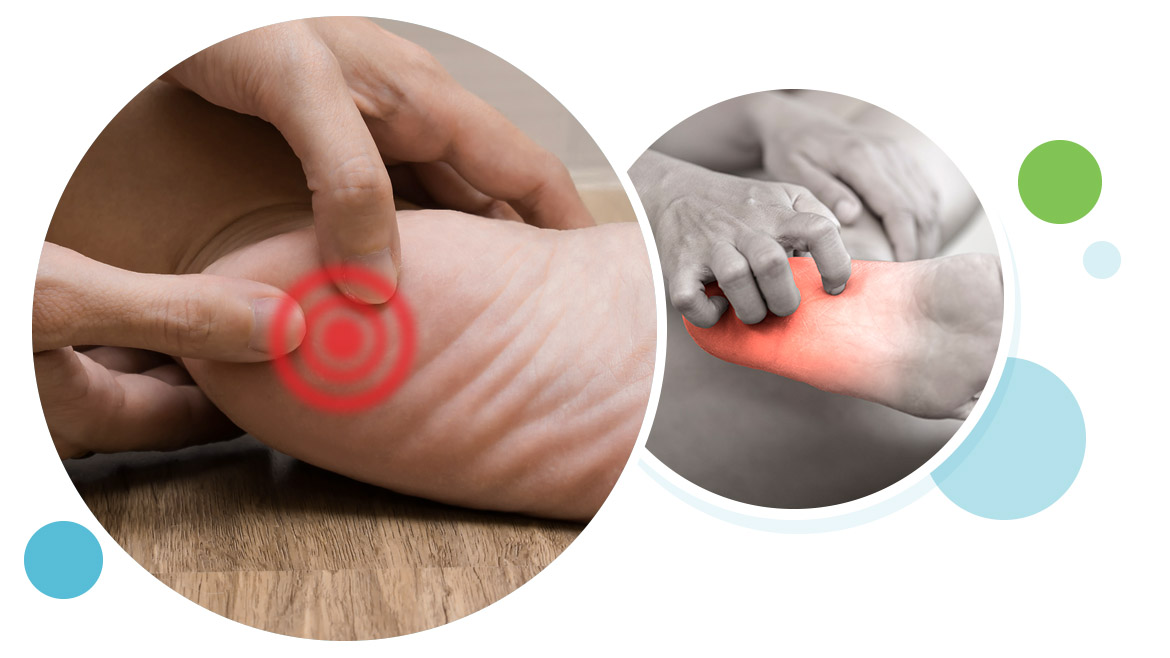Plantar Fasciitis
Plantar fasciitis is the most common cause for heel pain and one of the most common conditions treated by podiatrists. It may also be called heel spur syndrome if there is a heel spur present. It occurs when there is an inflammation of the plantar fascia. This band of tissue reaches from the heel to the toes and plantar fasciitis occurs when the fascia first gets irritated then becomes inflamed. This inflammation causes severe heel pain. Sometimes plantar fasciitis can be effectively treated at home, but it often requires intervention and care by a physician.
Plantar Fasciitis Details
Stress caused to the plantar fascia whether it be a small increase in weight gain or an increase in activity are some of the primary causes of plantar fasciitis in the general population. Those who have arch problems, such as high arches or flat feet are more likely to suffer from the condition. When an individual wears footwear that doesn’t have enough support on flat, hard surfaces, it can put an abnormal strain on the plantar fascia and cause the condition. This is particularly true if one has a job that requires long hours on the feet, such as in a factory, warehouse, or retail environment. Other contributors to plantar fasciitis include obesity, overuse, high impact exercise, and age.
Plantar Fasciitis Symptoms
There are several symptoms that someone with plantar fasciitis might experience. Many of those with the condition say that the pain is worse after they have been sitting for a long time or when they first get up in the morning. The pain decreases after walking for a few minutes or gently stretching the fascia. The pain might subside with walking but return after spending long periods of time on one’s feet. Generally, symptoms can restart if one takes a long lunch break or rest, usually greater than half an hour. Here are some common symptoms that accompany plantar fasciitis:
- Pain in the arch.
- Pain in the bottom of the heel.
- Pain that is worse when waking up in the morning.
- Swelling on the bottom of the heel.
- Pain that progresses over a period of a few months.
Diagnosing Plantar Fasciitis
A podiatrist will need to diagnose plantar fasciitis using multiple tests. The doctor will ask about your medical history and will conduct a physical examination of your foot. All other possible causes for the condition will be ruled out. Your doctor will order diagnostic imaging studies, such as MRIs, ultrasound and x-rays, which can distinguish the different kinds of heel pain. Heel spurs are sometimes found in those who have plantar fasciitis, but heel spurs are rarely a cause for pain. When heel spurs are present, the doctor might diagnose the condition as heel spur syndrome/plantar fasciitis.
Treatment for Plantar Fasciitis
Treatment for plantar fasciitis can be difficult as surgery is not common and improvement comes from an extended effort to rehab the tendons. Much of the rehab can be done by the patient at home. Here are the first-line treatment options:
- Avoid going barefoot because of the extra stress and strain on your plantar fascia.
- Using an ice pack with a thin towel around it on your heel 20 minutes at a time several times a day to reduce inflammation.
- Stretching exercises that stretch the calf will help with recovery and stretch out the calf muscles.
- Oral non-steroidal anti-inflammatory medications (NSAIDs) can help with inflammation and pain.
- Wearing supportive shoes with a slightly raised heel and good arch support will reduce the stress the plantar fascia experiences.
- Reducing extended physical activities so your heels can rest.
If the pain continues after a few weeks, you will need to see your podiatrist who will add other treatments. Some of those non-surgical treatments will include:
- Strapping, padding or taping, which will soften the impact of walking, support the foot and reduce the strain the fascia experiences.
- Applying custom orthotic devices inside your shoe to help with any underlying structural abnormalities that contribute to or cause plantar fasciitis.
- Fitting a removable walking cast or boot to help immobilize the foot for a few weeks. This way the ligament can rest and heal properly.
- Corticosteroid injections may be given to help relieve pain and reduce inflammation.
- Physical therapy and other exercises to stretch and strengthen the calf and plantar fascia.
- Fitting a night splint to help the plantar fascia have an extended stretch while sleeping. This will help to reduce morning pain and the chance of aggravating the injury.
A small number of those who have plantar fasciitis will require surgical intervention. If several months of non-surgical treatment don’t ease the heel pain, your doctor might discuss surgery. Your doctor will determine which surgical approach is best for your situation. The most common approaches to surgical treatment are Plantar Fascia Release Surgery, generally performed endoscopically.
Recovery
The recovery period from surgical intervention is generally no more than a few weeks of non-weight bearing in a cast or boot. No matter the treatment plan you undergo for plantar fasciitis, the underlying causes of the condition remain. You will need to continue the recommended preventative measures to avoid future problems. Continue with physical therapy, stretching exercises, wear supportive shoes, and use customized orthotic devices as long-term treatment to avoid future episodes of plantar fasciitis.

